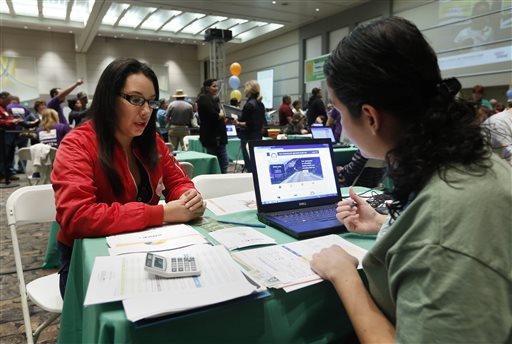(AP) Health exchanges slow to attract young, healthy
By MICHAEL R. BLOOD
Associated Press
LOS ANGELES
Fears that insurance exchanges that are the linchpin of President Barack Obama’s federal health care overhaul wouldn’t attract the young, healthy people needed to make them financially viable are being heightened by the early results of signups in several states.
If it becomes a trend, that could lead to increases in insurance premiums and deductibles next year. Along with the paltry enrollment numbers released this week, officials in a handful of states said those who had managed to sign up were generally older people with medical problems _ those with the greatest incentives to get coverage.
It’s unclear whether that will persist. Young, healthy people may be more inclined to procrastinate, especially given doubts about the law’s technically flawed online signup system. They have until Dec. 15 to sign up if they want to be covered on Jan. 1.
Insurers have warned that they need a wide range of people signing up for coverage because premiums paid by adults in the younger and healthier group, between 18 and 35, are needed to offset the cost of carrying older and sicker customers who typically generate far more in medical bills than they contribute in premiums.
The first set of enrollment data revealed that 106,000 people signed up for coverage nationwide, far short of the 500,000 initial sign-ups the Obama administration had expected. In states where officials discussed more detailed information, it also became apparent that the people who flocked to the exchanges after they opened Oct. 1 were those who were desperate for coverage.
In California, the state with the largest uninsured population, most of those who applied were older people with health problems, according to a state health care official. In Kentucky, nearly 3 of 4 enrollees were over 35. In Ohio, groups helping with enrollment described many of those coming to them as older residents who lost their jobs and health coverage during the recession.
That people with serious health conditions would be the first to take advantage of the Affordable Care Act was expected. But that direction must shift.
In general, someone in his 60s uses $6 in health care services for every $1 tallied by someone in his 20s, said Nicole Kasabian Evans of the California Association of Health Plans. That makes younger adults a coveted group on industry balance sheets.
If those signing up trend to the elderly and sickly “your insurance is going to cost more and that will discourage those younger people from coming in,” warned Lisa Folberg, a vice president with the California Medical Association. Faced with steep prices, younger people could opt to pay a government fine rather than purchase coverage.
The potential for rising monthly premiums and higher policy deductibles is just one deterrent to convincing young people to sign up for coverage on the exchanges. The technological problems that have plagued the federal exchange, which is running in 36 states, and many state-run online marketplaces are slowing enrollment. And scattered reports of data breaches have the potential to scare off even more people.
Efforts to attract adults younger than 35, often referred to as “young invincibles,” include multimillion dollar advertising campaigns, which have launched in several states.
In California, Peter Lee, director of the state-run health exchange, said his state’s outreach effort taps social media, radio and TV ads, and events at churches, community centers and other venues. To emphasize the point, Covered California included a 27-year-old man who had signed up for coverage during its news conference this week. The focus aims to counter the current trend in the state. Lee described October enrollees in California as “older people or people who have health conditions.”
In Colorado, an aggressive campaign from allies of the state-run exchange includes provocative ads. One targeting women combines the promise of free birth control pills with the notion of casual sex. Another ad shows women with a contraption made of alcohol shot glasses glued to an old snow ski. “Saving money on flu shots leaves us more money for fun shots,” the ad reads. The day the health exchange launched, male and female models wearing nothing but underwear and “Get Covered” signs passed out fliers on a downtown Denver street.
It’s not clear whether the campaign is working. Colorado’s exchange has yet to release a demographic breakdown of the 3,700 people who selected an individual policy last month.
If such efforts fail and insurance companies end up with too many sick or expensive customers, they might need to increase premiums or eventually leave markets to avoid taking heavy financial losses.
Aetna Chairman and chief executive Mark Bertolini said last month that it was “incredibly important” to get the exchange websites running properly because “the younger, healthier people aren’t going to give them more than one shot.”
___
Associated Press writers Roger Alford in Frankfort, Ky., Carla K. Johnson in Chicago, Tom Murphy in Indianapolis, Ann Sanner in Columbus, Ohio, Juliet Williams in Sacramento, Calif., and Kristen Wyatt in Denver contributed to this report.
Lack of Younger Enrollees Threatens Exchanges

COMMENTS
Please let us know if you're having issues with commenting.